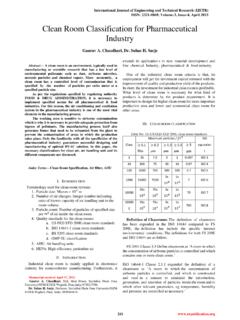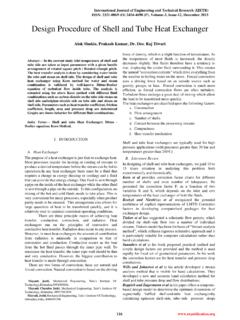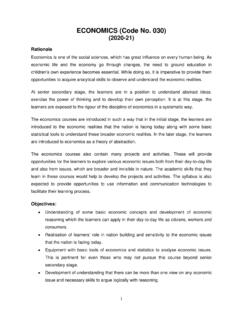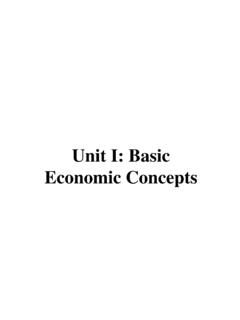Transcription of The Concept of Productivity
1 International Journal of Engineering and Technical Research (IJETR) ISSN: 2321-0869, Volume-3, Issue-5, May 2015 192 Abstract Although the Concept of Productivity is a widely discussed subject by politicians, economists, managers and media, it is often vaguely defined and poorly understood. In practice, this lack of knowledge results in Productivity being ignored by those who influence production processes. The purpose of this paper is to discuss the basic meaning of Productivity as well as its relation to other similar terms. Index Terms Productivity , I. INTRODUCTION A simple way of looking at Productivity in a business organization is to think of it in terms of the Productivity model below.
2 Essentially, Productivity is a ratio to measure how well an organization (or individual, industry, country) converts input resources (labor, materials, machines etc.) into goods and services. This is usually expressed in ratios of inputs to outputs. That is (input) cost per (output) good / service. It is not on its own a measure of how efficient the conversion process is. Productivity is an average measure of the efficiency of production. It can be expressed as the ratio of output to inputs used in the production process, output per unit of all outputs and inputs are included in the Productivity measure it is called total Productivity . Outputs and inputs are defined in the total Productivity measure as their economic values. The value of outputs minus the value of inputs is a measure of the income generated in a production process.
3 It is a measure of total efficiency of a production process and as such the objective to be maximized in production process. Productivity measures that use one or more inputs or factors, but not all factors, are called partial productivities. A common example in economics is labor Productivity , usually expressed as output per hour. At the company level, typical partial Productivity measures are such things as worker hours, materials or energy per unit of production. In macroeconomics the approach is different. In macroeconomics one wants to examine an entity of many production processes and the output is obtained by summing up thevalue-added created in the single processes. This is done in order to avoid the double accounting of intermediate inputs.
4 Value-added is obtained by subtracting the intermediate inputs from the outputs. The most well-known and used measure of value-added is the GDP (Gross Domestic Product). It is widely used as a measure of the economic Pooja Yadav, Dept. of Mechanical Engineernig, Manav Rachna International University, Faridabad, India,+919711538207. Guide: Col. Sachin Marwah, Dept. Of mechanical Engineering,Manav Rachna International University, Faridabad, India, +919818474690. growth of nations and industries. GDP is the income available for paying capital costs, labor compensation, taxes and profits. For a single input this means the ratio of output (value-added) to input. When multiple inputs are considered, such as labor and capital, it means the unaccounted for level of output compared to the level of inputs.
5 [1] This measure is called in macroeconomics Total Factor Productivity TFP or Multi Factor Productivity MFP. Productivity is a crucial factor in production performance of firms and nations. Increasing national Productivity can raise living standards because more real income improves people's ability to purchase goods and services, enjoy leisure, improve housing and education and contribute to social and environmental programs. Productivity growth also helps businesses to be more profitable. Productivity is an overall measure of the ability to produce a good or service. More specifically, Productivity is the measure of how specified resources are managed to accomplish timely objectives as stated in terms of quantity and quality. Productivity may also be defined as an index that measures output (goods and services) relative to the input (labor, materials, energy, etc.)
6 , used to produce the output). As such, it can be expressed as: Hence, there are two major ways to increase Productivity : increase the numerator (output) or decrease the denominator (input). Of course, a similar effect would be seen if both input and output increased, but output increased faster than input; or if input and output decreased, but input decreased faster than output. Organizations have many options for use of this formula, labor Productivity , machine Productivity , capital Productivity , energy Productivity , and so on. A Productivity ratio may be computed for a single operation, a department, a facility, an organization, or even an entire country. Productivity is an objective Concept . As an objective Concept it can be measured, ideally against a universal standard.
7 As such, organizations can monitor Productivity for strategic reasons such as corporate planning, organization improvement, or comparison to competitors. It can also be used for tactical reasons such as project control or controlling performance to budget. Productivity is also a scientific Concept , and hence can be logically defined and empirically observed. It can also be measured in quantitative terms, which qualifies it as a variable. Therefore, it can be defined and measured in absolute or relative terms. However, an absolute definition of Productivity is not very useful; it is much more useful as a Concept dealing with relative Productivity or as a Productivity factor. Productivity is useful as a relative measure of actual output of production compared to the actual input of resources, measured across time or against common entities.
8 The Concept of Productivity Pooja Yadav, Marwah The Concept of Productivity 193 As output increases for a level of input, or as the amount of input decreases for a constant level of output, an increase in Productivity occurs. Therefore, a " Productivity measure" describes how well the resources of an organization are being used to produce input. Productivity is often confused with efficiency. Efficiency is generally seen as the ratio of the time needed to perform a task to some predetermined standard time. However, doing unnecessary work efficiently is not exactly being productive.
9 It would be more correct to interpret Productivity as a measure of effectiveness (doing the right thing efficiently), which is outcome-oriented rather than output-oriented. II. COMPONENTS OF PRODUCTIVTY Productivity has been generally defined as a ratio of a measure of output to a measure of some or all of the resources used to produce this output. Defined in this way, one or a number of input measures can be taken and compared with one or a number of output measures. When attempts are made to include all inputs and all outputs in a system the measure is called a total Productivity measure (TPM). The inputs used in a process can be hours of labor, units of capital, and quantities of raw materials compared with the consequent output. Revisiting the Productivity Conceptual Model, the roots denote the inputs to the system, the trunk the conversion process and the branches, leaves and fruits the systems outputs.
10 The model shows two fundamental problems: 1. Selecting different factor, inputs and outputs, can derive different measures of Productivity . 2. The diversity of the sum of the factor inputs and outputs, many of which are of a qualitative nature. Notwithstanding these, there is little debate about the need to be able to measure Productivity , for without it comparisons of performance are not feasible and control action cannot be properly taken. The question is 'what do we measure, and how do we collect and analyze the data we collect?' What factors are chosen for measurement, how important these are, and how that measurement is made is probably best gained from an analysis of the specific reasons why companies should wish to measure Productivity . The following are the main reasons why Productivity is required to be measured.












